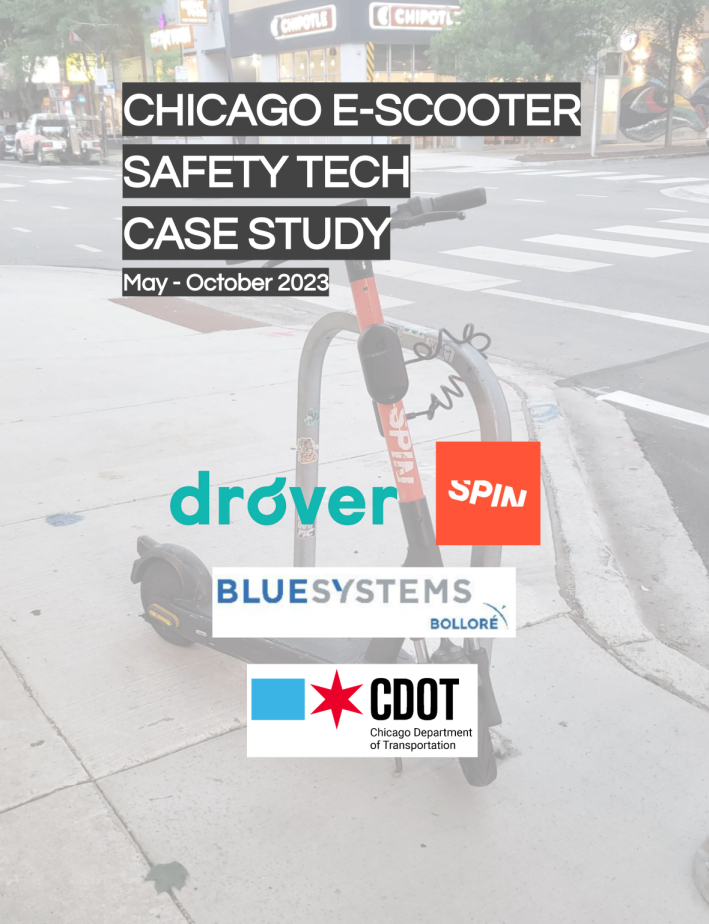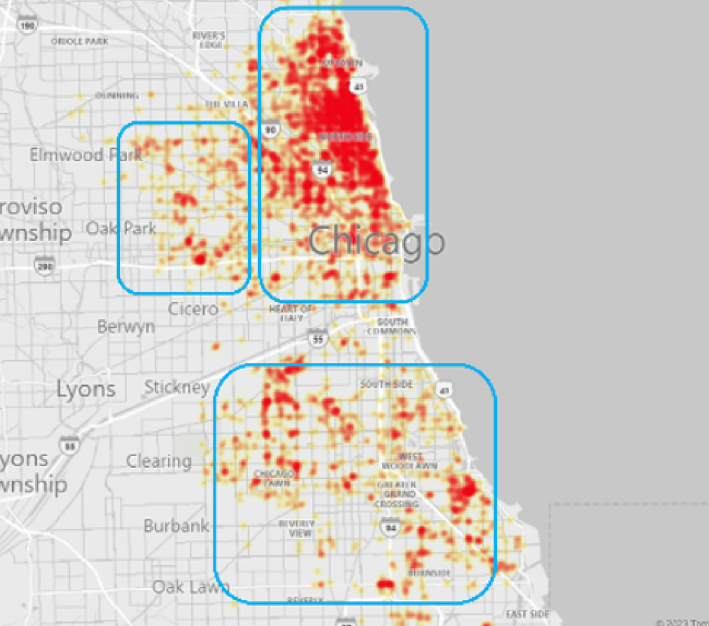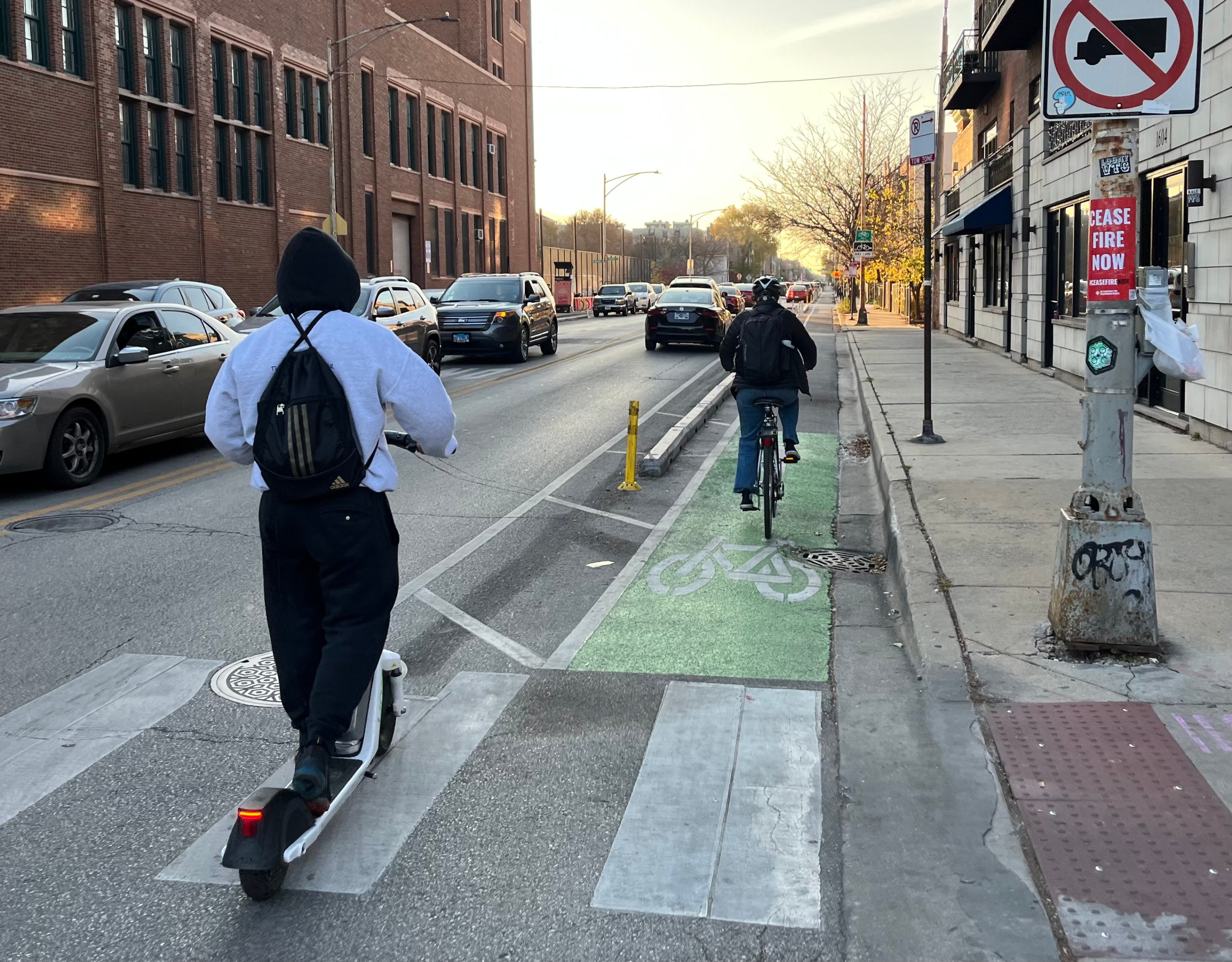
Ask any Chicagoan’s opinion on the shared electric scooters that descended on the city at the start of the decade and responses will range from enthusiasm for a fun car-free micro-mobility option, to irritation at a new public nuisance illegally ridden on sidewalks, littering sidewalks, and hanging from the occasional tree. A study published by scooter vendor Spin and technology company Drover makes the case that the technology onboard e-scooters can keep scooter riders off sidewalks, can ensure the vehicles are parked properly, and is a valuable tool for urban planning and possibly even parking enforcement.
In 2019 and 2020 the city of Chicago ran a pilot of shared e-scooters with three vendors, including Spin. You may remember scooters haphazardly heaped near 'L' stations, laying across sidewalks and floating in the Chicago River. The City Council ultimately voted to make the scooter program permanent, with constraints on where the vehicles can be operated and parked. All shared e-scooters must be equipped with sidewalk-detection technology designed to keep riders off walkways. Out-of-use scooters must be parked upright and locked to a pole, bike rack, or other suitable object.

The Spin and Drover study, dubbed the Chicago E-Scooter Safety Tech Case Study, looks at the effectiveness of “nudges” – in this case chimes and speed controls that kick in when a rider steers onto a sidewalk – while mapping where sidewalk riding happens most. The study – done in partnership with the Chicago Department of Transportation, which oversees the scooter program, and Blue Systems – was conducted from May through October of 2023, collecting data from 480 Spin vehicles in our city and almost 24,000 rides.
It may come as no surprise that scooter riders most frequently diverted to sidewalks in the absence of bike lanes (which are legal for them to use in Chicago), or at busy intersections where bikeways disappear. An example cited was the intersection of Clark (1100 W.) and Addison (3600 N.) streets, in front of Wrigley Field. Riders also frequently moved to sidewalks on wide streets with fast-moving traffic and no bike lanes like Garfield Boulevard (5500 S.) In areas with good bike infrastructure, scooter riders stayed in the bike lanes and off sidewalks, like along Martin Luther King Drive (400 E.) in Washington Park. Color-coded maps in the study show spots where scooter riders diverted to sidewalks or stuck to streets, and the infrastructure present.

Fleets of scooters equipped with GPS and AI cameras collected lots of ground-level data on road conditions and its relationship to rider behavior. The study states that this information can be used by urban planners to prioritize areas for investment. CDOT spokesperson Erica Schroeder said data from all of Chicago’s micro-mobility vendors are shared with the agency and used in decision-making about bike and pedestrian improvements. She wrote, “CDOT uses a data dashboard to aggregate all shared e-micromobility trips across all vendors (Divvy e-bikes and scooters, and Lime and Spin scooters) which give a fuller picture of where and when trips are happening. CDOT uses this data as a variable in our infrastructure planning efforts."
The case study also recommended using camera footage from scooters for enforcement of vehicles illegally parked in bike lanes – an all-too-common and dangerous occurrence that forces bikes to merge into traffic. The AI cameras on board Spin e-scooters capture detailed information on vehicles blocking the right of way, and their exact location. The study says this technology could be a tool for Chicago's yet-to-be-implemented Smart Streets Pilots ordinance, which authorizes the city to use photo enforcement to ticket for parking violations. However, CDOT's Schroeder stated that the city is not pursuing using this technology for parking enforcement.
Advocacy group Bike Lane Uprising, which fights bikeway obstruction, has been collecting photos of bike lane parking violations for six years, crowdsourced from hundreds of bicycle riders and submitted via an app. The BLU database has amassed over 50,000 bike lane obstruction entries, which forced the app into a temporary hiatus in 2022 while the organizers arranged for more space.

The scooter case study also concluded that the chimes and speed controls on Spin scooters encouraged good behavior because of an overall decrease in people riding scooters on sidewalks, and an increase in them using bike lanes, during the six-month study. It would be interesting to see if the nudges had a positive effect year over year; the charts show people rode on the sidewalk the least in June, July and August – the time of year with the most hours of sunlight. Sidewalk riding increased in frequency, distance and duration again in the fall, which suggests scooter riders might be concerned about their safety and visibility to drivers in the darker months.
Schroeder pointed out that the study doesn’t necessarily paint a full picture of shared scooter use since it covered only one scooter brand, for a limited time period. However, it’s safe to conclude that good bicycle infrastructure not only improves safety for people on bikes, but also encourages scooter riders to keep off sidewalks, strengthening the argument for e-scooters as a public good instead of an annoyance.
Check out the study via LinkedIn here.

Did you appreciate this post? Please consider making a tax-deductible donation.





